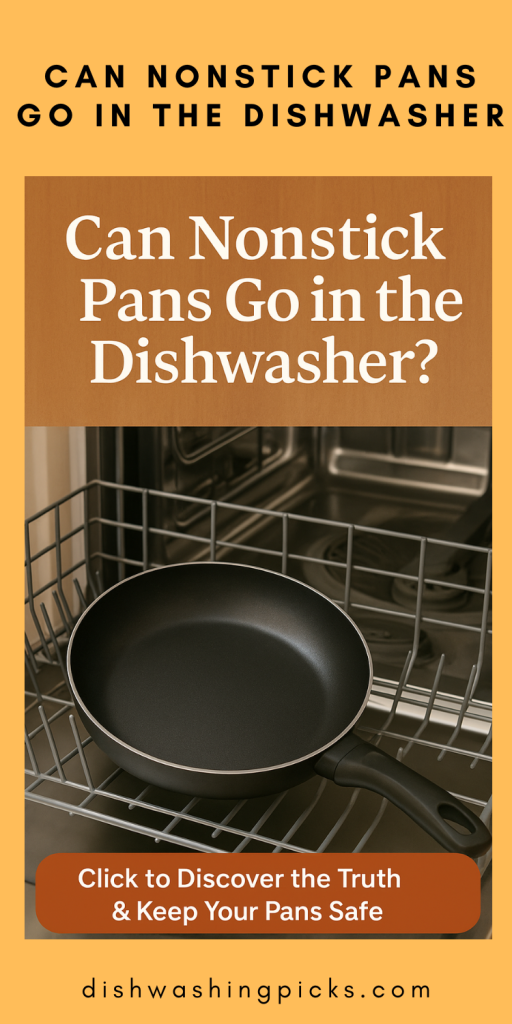Alright, picture this: You’ve just cooked a flawless cheese omelet. No sticking, no mess, just a silky, golden dream sliding right off your beloved nonstick pan. You feel like a culinary hero… until you see the mountain of dirty dishes waiting for you in the sink.
Now here’s the million-dollar question: Can you just toss that nonstick pan in the dishwasher and call it a day?
If you’ve ever hovered over your dishwasher with a pan in hand, debating whether it’s “dishwasher safe” or if you’re about to ruin your favorite cookware, you’re not alone. We’ve all been there, staring at that “pots and pans” cycle like it’s a game of culinary roulette.
Here’s the deal: The answer isn’t as simple as “yes” or “no.” There’s a bit of nuance (and some fine print manufacturers really hope you’ll read). But don’t worry—I’ve got you. We’re about to break it all down in plain English, no jargon, no guilt-tripping.
Before we get into what dishwashers actually do to nonstick coatings, let’s take a quick step back and talk about what nonstick pans are really made of—and why that matters.
What’s really on that pan?
Okay, so here’s the thing most of us don’t think about when we’re buying a shiny new skillet: What makes a nonstick pan nonstick in the first place?
It’s all about the coating. Most modern nonstick pans are coated with PTFE (you’ve probably heard the brand name “Teflon”), or sometimes ceramic-based coatings. These surfaces are designed to keep food from clinging, which means less scrubbing for you.
But here’s the catch—these coatings aren’t invincible. Over time, they can break down, chip, or lose their magic slickness. And yes, how you clean them plays a huge role in how long they last.
Imagine this: You baby your pan, using only soft spatulas and low heat, but then you blast it in a dishwasher with scorching water, strong detergent, and a storm of plates banging around. Doesn’t exactly sound like a spa day for your cookware, right?
This leads us to the big question: What does the dishwasher actually do to these coatings—and should you risk it?
What the Dishwasher Actually Does to Nonstick Pans
Here’s the uncomfortable truth: dishwashers aren’t exactly gentle. They’re more like a car wash on steroids—scalding hot water, powerful detergent, and jets spraying like they’re trying to strip paint. Great for plates. Not so great for delicate coatings.
1. The Heat Factor
Dishwashers use extremely hot water (sometimes up to 160°F/70°C) to sanitize your dishes. That’s way hotter than your stovetop ever gets on low heat. Over time, that heat can warp the pan or weaken the bond of the nonstick coating.
2. The Detergent Problem
Dishwasher detergents aren’t mild. They’re loaded with harsh chemicals designed to cut through baked-on grime and grease. Sounds great for lasagna pans, right? But those same chemicals can slowly erode the slick surface of your nonstick coating.
3. The Banging Around
Let’s not forget the “dishwasher shuffle.” You toss in plates, glasses, cutlery, and that pan is sitting there getting knocked by everything else in the load. Tiny scratches from that contact can turn into bigger problems fast.
Now, here’s the twist—some manufacturers say their nonstick pans are dishwasher safe. And technically, they’re not lying. The pan won’t explode. The handle won’t melt off. But “dishwasher safe” doesn’t always mean “dishwasher friendly for the long haul.”
So what’s the verdict? Think of it like this: you can put nonstick pans in the dishwasher occasionally—but should you make it a habit? That’s where things get tricky.
Let’s break down why some people toss them in without a second thought, and why others treat their pans like royalty and hand wash every single time.
The “You Can” vs. “You Shouldn’t” Debate
Here’s where it gets interesting—you’ll hear two very different camps when it comes to nonstick pans and dishwashers.
Camp 1: “Go ahead, it’s fine!”
These are the people (and even some manufacturers) who boldly stamp dishwasher safe on the box. Their logic? The pan won’t break, and it won’t turn into a lump of metal mush just because it sat through a rinse cycle. If you toss it in once in a while, no big deal.
Camp 2: “Hand wash, or else!”
Then there are the die-hard pan protectors, the ones who practically whisper to their cookware like it’s a houseplant. They’ll tell you the dishwasher is the fast track to a sad, flaky surface. And honestly? They’re not wrong—hand washing almost always extends the life of nonstick pans.
But here’s the nuance most articles skip: both camps are right in their own way.
- If you just dropped $120 on a high-end skillet you hope will last for years, maybe keep it out of the dishwasher.
- If your $20 pan is more of a “use it until it dies” situation, the dishwasher might be worth the convenience.
Even manufacturers are divided. Some premium brands like All-Clad or Calphalon will technically say their nonstick cookware is dishwasher safe—but in the fine print, they also “recommend hand washing for best results.” Translation? It won’t kill the pan, but it might shave years off its life.
Here’s the bottom line: the dishwasher won’t destroy your nonstick pan overnight, but it will speed up the wear-and-tear clock.
So, what should you do if you want to keep your nonstick pans looking and performing their best?
The Best Practices Guide — How to Clean and Care for Nonstick Pans the Smart Way
Alright, so we’ve established that dishwashers are a bit like that reckless friend who means well but always causes trouble. Now, let’s talk about what you should be doing if you actually want your nonstick pans to last.
1. Hand Wash, But Keep It Simple
Forget scrubbing like you’re sanding a boat. Warm water, a soft sponge, and a tiny dab of dish soap are all you need. Most of the time, food practically slides right off anyway—so no reason to attack the pan with steel wool like it owes you money.
2. Avoid Harsh Tools
Metal scrubbers? Big no. Abrasive sponges? Also a no. These can scratch the coating faster than you can say “why is my egg sticking now?” Stick to a soft sponge or a gentle dish brush if you really need to scrub.
3. Skip the Soak Marathon
It’s tempting to toss a greasy pan in the sink and let it soak for hours (or… days—no judgment). But soaking for too long, especially in very hot water, can also weaken that coating. A quick rinse while it’s still warm is your best bet.
4. Keep the Heat in Check
This isn’t strictly about washing, but it’s worth saying: blasting a nonstick pan on high heat is like giving it sunburn. Use medium or low heat most of the time—that keeps the coating happy and makes cleaning easier.
5. Treat Dishwasher Use as “Plan B”
If you must toss it in the dishwasher, do it occasionally—not every single night. And when you do, use the gentlest cycle possible. Oh, and don’t overcrowd it with heavy pots that could scrape against the surface.
By following these easy habits, you can stretch the life of your nonstick pans by years. Seriously.
But now let’s get practical—what if you already have a pan that’s been through dishwasher drama? Is there any way to revive it, or is it basically a lost cause?
Can You Rescue a Damaged Nonstick Pan—or Is It Game Over?
Here’s the hard truth: once a nonstick coating starts to go, there’s only so much you can do.
If your once-slick pan is now making scrambled eggs cling for dear life, you might wonder, “Can I bring it back? Is there some secret hack?”
Well… kind of, but with limits.
Minor scratches or dullness?
- You might still squeeze a little more life out of the pan. Using a tiny bit more oil or butter can help “fake” that nonstick feel for a while.
- There are also “nonstick sprays” and even DIY “reseasoning” tricks (heating a thin coat of oil in the pan) that can make it feel a bit smoother again.
Big flakes or peeling?
- Sorry, but that’s usually the end of the road. Once the coating starts coming off in chunks, not only is the pan useless—it’s also unsafe. You don’t want to risk little pieces of coating ending up in your food.
What about “re-coating” a nonstick pan?
- You’ll see claims online about services that “re-coat” nonstick pans, but honestly? It’s rarely worth it. The process is expensive, and you could just buy a new, quality pan for the same price—or less.
So here’s the real advice: take care of your nonstick pans before they get to the point of no return. Hand wash, treat them gently, and they’ll last years. Ignore them, and you’ll be buying replacements way sooner than you’d like.
But here’s something you might still be wondering—what about those “dishwasher safe” nonstick pans they brag about in stores? Are they any different—or just clever marketing?
Are “Dishwasher Safe” Nonstick Pans Actually Worth It—or Just a Label?
Ah, the magic words on the box: “Dishwasher Safe.” Sounds like a dream, right? You imagine tossing your pan in the dishwasher without a second thought, sipping your coffee while the machine does the work. But here’s the thing…
That label doesn’t mean what you think it means.
Manufacturers use “dishwasher safe” to mean the pan won’t completely self-destruct after one wash. The handle won’t melt, the base won’t warp beyond recognition. But does it mean the nonstick coating will stay perfect forever? Not quite.
Here’s the catch:
- Even “dishwasher safe” coatings will degrade faster under harsh detergents and high heat.
- The label is partly there because—let’s be real—people hate handwashing. It makes the pan seem easier to own.
But there are some pans built to handle dishwashers a little better:
- High-end ceramic-coated pans tend to be more resilient than traditional Teflon-style ones.
- Hard-anodized aluminum pans sometimes survive the dishwasher better (but even they lose some slickness over time).
So, is it a scam? Not really. It’s just… optimistic marketing. Think of it like jeans labeled “machine washable.” Sure, you can toss them in every time, but they’ll fade faster than if you took better care.
Here’s the takeaway:
- Dishwasher safe doesn’t mean dishwasher invincible.
- If you really want your pan to last, hand washing is still the gold standard—even for those fancy, supposedly indestructible pans.
The Final Verdict — Should You or Shouldn’t You Put Nonstick Pans in the Dishwasher?
Alright, let’s cut through all the “maybe this” and “technically that.” Here’s the bottom line:
- Yes, you can put most nonstick pans in the dishwasher.
They won’t explode, warp into modern art, or instantly lose all their coating. - But… should you?
Only if you’re okay with shortening their lifespan. Even “dishwasher safe” pans will slowly lose their magic if you keep tossing them in every night.
Think of it like this:
- The dishwasher is like running a marathon in heels—it can be done, but it’s not exactly the gentlest choice.
- Hand washing? That’s the cozy sneakers of pan care. It keeps things smooth, steady, and long-lasting.
When is it actually okay to use the dishwasher?
- When you’re exhausted and the thought of scrubbing makes you want to cry.
- When it’s a cheap pan you’re not emotionally attached to.
- When you’re willing to accept a little wear for the sake of convenience.
But if you splurged on a fancy, high-end nonstick pan? Treat it like royalty—hand wash it, use soft sponges, and keep that heat on medium.
Because here’s the truth nobody puts on the box: taking a few extra seconds at the sink now can save you from buying another pan next year.

